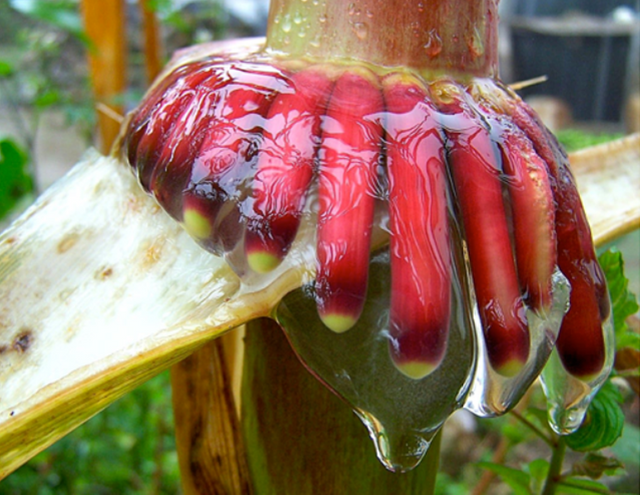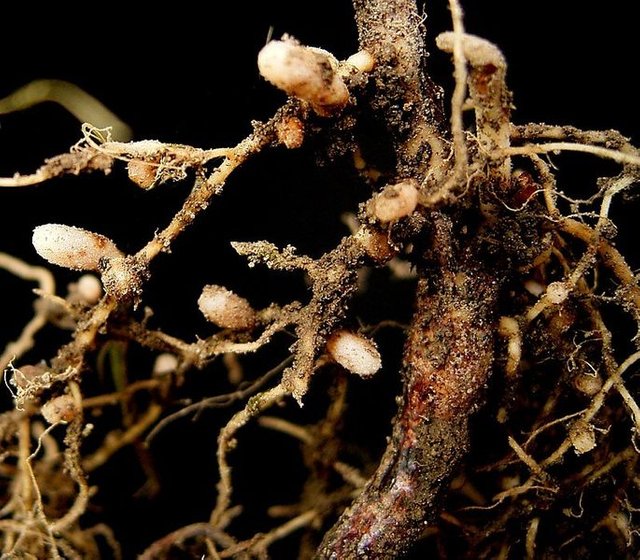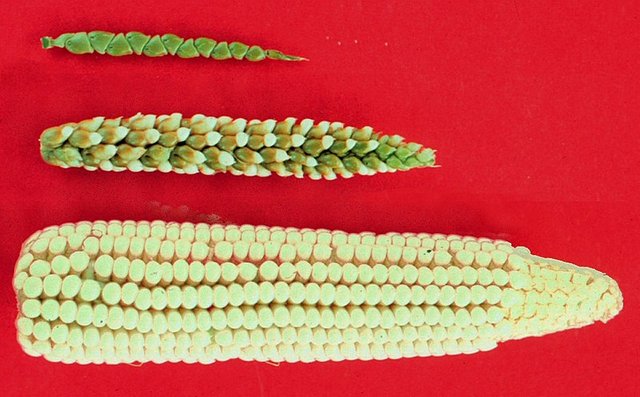Bugs in the news: Corn snot helping end hunger and pollution
Believe it or not, there's no need for a nsfw tag. What you're looking at is a very special corn root. In fact, it's so special, it took researchers over 8 years to be sure about what they were looking at. These roots aren't in soil, are covered with a hefty helping of slime, and host a thriving community of very special microbes.ref

Behold the beauty of nature. Image from Fig. 2 of the research article released by Deynze et al. as open access
Nitrogen is the N in CHONPS, the big elements of life. Despite its importance, nitrogen can be rather hard to come by in a usable form. Even though something like 78% of our atmosphere is nitrogen, the form it takes (N2 or dinitrogen) has an incredibly stable and hard to break triple bond1, making it difficult for life to use (bioavailability). Because of this, there's no apparent end to the wacky hijinks organisms will go through to get their necessary nitrogen.
We humans are not excluded. Our wacky hijinks boil down to careful stewardship of the land and coplanting, which are excellent but may not be scalable, or by using copious amounts of (often polluting, non-renewable) energy to zap dinitrogen into a more useful form. Fortunately for us, the wacky hijinks used by the snotty corn (officially a landrace of corn from Oaxaca, Mexico) may eventually give us another option.
Of crops and cooperation
Here's what you need to know. All plants need nitrogen to grow, yet none of them2 can convert (fix) dinitrogen into useful form. Luckily, there are special bacteria which excel at doing just that. An even luckier for some plants is that they've formed a very close relationship with those bugs - in return for providing a comfy home full of carbon in their root nodes, these plants get nitrogen from symbiotic nitrogen fixing bacteria (rhizobia).

Lotus root with rhizobial nodules, source by Frank Vincentz under CC3
Unfortunately for many plants, and for us, this association doesn't happen in every plant. Rhizobial symbiosis is largerly limited to legumes, and while beans and such are staple foods, we produce far, far more cereals. And cereals, unfortunately, don't have little bug buddies. This is why we've done things like rotate crops or do three-sister plantings. It's also why we are polluting the world at both ends.
Sounds like it'd be a good idea to fix that, doesn't it? Well, there's been no lack of effort on that front, but with little success. Should such a breakthrough occur, I wouldn't be surprised if it led to some people getting a trip to Stockholm.
Of course, I've shown you a picture of slimy corn roots, so you can imagine there may be another way forward, and therein lies a story.
Our ecological heritage
It's pretty gradeschool stuff to point out that corn (or maize) was an essential crop in pre-Columbian America and continues to be extremely important. What's still somewhat well-known but obscure enough to win you a pint at pub trivia is that our corn of today is the product of centuries of selective breeding of a less-bountiful plant, called teosinte

The evolution of corn, source by John Doebley under CC3
What's really, really cool is that when you have a crop with a history like that, there's all sorts of heritage versions, offshoots, and relics that are interesting in their own right, are associated with often rich cultural histories, and provide a nice genetic pool in case stuff goes south with your monoculture.
And thus, our story really begins. Dr. Shapiro so probably wasn't thinking much about nitrogen fixation while trekking along in mexico3. He was there at the behest of the Mexican government, recording and cataloging all the local varieties of maize which comprise the cousins of modern day corn.
While working in the Sierra Mixe region of Mexico, he came across an interesting variety. Although slow growing, it grew to towering heights of over 5m (the average for modern corn is about 4m)4. Moreover, it did so on ground that was remarkably poor in nitrogen. And, of course, there were all those bright red roots, sticking out in the air, and covered in goo.
Dr. Shapiro was no slouch, and immediately suspected that maybe there was some sort of N fixing going on and that maybe it had something to do with the slime. However, suspecting is not the same as knowing.
Science, done right
In this day and age of frequent publication of studies showing that Xcauses/cures baldness, due to an uncontrolled, un-randomized non blinded study of 10 participants who answered a voluntary survey, it's kind of refreshing to see someone take their time and do things thoroughly. All the more so because remember, claiming that a cereal is in a symbiotic relationship5 for nitrogen borders on being an extraordinary claim and should be accepted only with evidence which also borders on the extraordinary.
The authors used multiple experimental approaches and were quite honest about how each approach may have gone wrong. Taken together, their work (which used at least five approaches and spanned eight years) makes a very convincing case that corn is, in fact, working with bugs to get nitrogen. Specifically, the goo coming from the roots provides specific sugars and a low oxygen environemnt favoring nitrogen-fixers. The fixers, in turn, are providing nitrogen - up to 80% of the nitrogen used by the plant, in fact.
This is really cool stuff to an ecologist. But it gets even cooler - the bugs living in the 'snot' (mucilage) are demonstrably different from those living on other parts of the corn. In fact the bugs involved in this symbiosis are different from those we associate with legume roots!

A PCoA plot showing how much the bugs differ between parts of the corn. What's a PCoA plot? Glad you asked. Image from Figure 3a of the research article released by Deynze et al. as open access
The degree of thoroughness is commendable enough, but I also want to point out a few other things. First of all, and very importantly, we need to remember this corn is part of the cultural heritage of the local people. Insofar as I can tell, the authors have gone to great lengths to scrupulously follow the Nagoya protocolspdf, which are a set of rules enacted to help combat biopiracy.
Beyond that, you may have noticed that I've included actual graphs and data from this research. In fact, you may even followed my link to and read the journal article - even though this seems like a no-brainer for publicly funded research, that is frequently not the case. I commend the authors for publishing in a open journal, allowing the knowledge to flow freely.
Will it work and what's next
That's not to say there's not a long way to go. It's an open question whether this can be adapted to our crops. We can't just transplant the strain of corn, because even though it grows in other climes, commercial corn should have a growing season of 3 months, while this strain has a season of 8 months.
There's a whole passel of work to do involving either modifying6 either existing crops to produce goey aerial roots or in making the strain itself more commericially viable. There's also the implication that this might be happening in other cereals or researching how to transfer it over. Rice, for example also doesn't fix its own nitrogen is is responsible for about 20 percent of the world's caloric intake and and a correspondingly huge nitrogen use.
In closing
I never know how to close. However, I present to you one of the researchers - Dr. Shapiro. He works for Mars, an industrial partner on this research, and seems to be an all-around good guy. As a bearded gentleman myself, I'm a bit envious. I'm linking to a TEDx talk of his which y'all may be interested in.
Footnotes
1. Although it may not be the triple nature that makes it so strong.
2. That I know of.
3. Many popular press sites have done a story on this, I am giving The Atlantic the link love simply because their URL for the story is the best.
4. For ye olde alchemists and those living in backward countries, that be 16 feete instead of the half-score-and-two ye are accustomed to.
5. Yes, yes, I acknowledge the Michael Pollan thing pointing out that corn is in a symbiotic relationship for nitrogen with humans.
6. Genetically or otherwise.
You had me at half-score and two... nice article @effofex!
I was had at “corn snot”.
I second that one @blewitt!
It’s truly an appetizing term. Now I hunger!
Hahahahaha!
What other foods can @effofex ruin for me today?!?!?
That is a dangerous question to ask.
I love shitty eggs.
Hahahahaha
@snowyknight I was quite proud of that one.
You should be!
I think this is cool and simultaneously worrying - I'm allergic to almost all cereals. My allergy self is concerned soon there will be foods chockablock with corn proteins making me rash and not knowing why. ;) Maybe that's not how corn snot modified into other potential plants will work, but my allergies make me paranoid! XD
Like honestly, that's my biggest GMO question, and I can't find diddly squat about it when I've looked. If they're using, say, a shellfish gene, and I'm allergic to shellfish, will it have the proteins that set me off in the modified food? Is this a possible reason for the spike in food allergies in the world? I don't know. I want more studies!
@phoenixwren I'd never even thought about the allergen aspect, so thanks for bringing that up. In fact, it lead me intoa nice cozy research dive and I'm very strongly considering writing a post about it. In the mean time, the short answer is that you probably don't have to worry about it, at least relative to your risk from incidental contamination due to processing.
That's good to know; I'd love to read a post about what you found! When I've tried in the past I didn't have much luck.
wow, that's seriously cool corn. And bugs. And great ethical standards of the scientists, it seems. Ty for this report.
@sco You're welcome. As soon as I saw the picture, I was interested. When I read the synopsis of what the goo meant, I knew it was my next article. THEN the ethical standards became apparent and I was delighted.
Okay, it took me a while to get that that was slime and not water covering the roots! I'm tired...
I'm afraid that biology is a touch on the thin side for my knowledge, but I am impressed at the "science done right" part. Part of this problem is the media reporting of preliminary results, but the adage that you quote, extraordinary claims require extraordinary evidence seems to have fallen by the wayside in recent times... However, that said, this is an interesting claim!
@bengy Another piece of the problem is the push to shovel papers out as quickly as possible. Combine that with a bias against negative results and massive (but not deliberate) misunderstanding of stats, and well...
Oh yes, all of those have contributed in a systemic way (with perverse incentives). The stats problem is depressingly large (especially in the non physical sciences)...
Keep on writing and stay curious!
It look so bizarre at first glance.
Never seen a corn root like that one before and I agree With thia statement: 👇🏻
@effofex Have a nice day to you and the awesome Dr. Shapiro!
If only more people took this to heart.
That is one heck of an unusual look of a corn root.
I have always heard of the evolution of the corn and how it as not consumable at all when it's in its wild state.
The more interesting part is that how human sees it as a potential and then put effort to cultivate it into something edible, and now with this discovery, indeed it is researched done right.
upvoted
@littlenewthings Yeah, that look is rather striking.
Congratulations! Your post has been selected as a daily Steemit truffle! It is listed on rank 3 of all contributions awarded today. You can find the TOP DAILY TRUFFLE PICKS HERE.
I upvoted your contribution because to my mind your post is at least 11 SBD worth and should receive 143 votes. It's now up to the lovely Steemit community to make this come true.
I am
TrufflePig, an Artificial Intelligence Bot that helps minnows and content curators using Machine Learning. If you are curious how I select content, you can find an explanation here!Have a nice day and sincerely yours,

TrufflePigCongratulations @effofex! You have completed the following achievement on Steemit and have been rewarded with new badge(s) :
Click on the badge to view your Board of Honor.
If you no longer want to receive notifications, reply to this comment with the word
STOPYou have a minor misspelling in the following sentence:
It should be surprised instead of suprised.I wanna be slightly peeved, but this bot helped me fix a typo, so meh.
Still not as impressive as other technology here that see poems!
@snowyknight I need to look at the bot's response and see if we can trick it into correcting a 'mistake' such that its correction is a haiku, potentially summoning the other one.
Bots correcting bots! How the words would fly that day. Jabbering. Unheard.
I am fully with you @effofex. Someone like the Grammer bot, so intentionally spell it wrong so that that it asks us to change the spelling but then the spelling permits a haiku. Is that what you mean?
Then? No more need of humans! Hahaha joking we have a couple of years, I hope...
Good points!